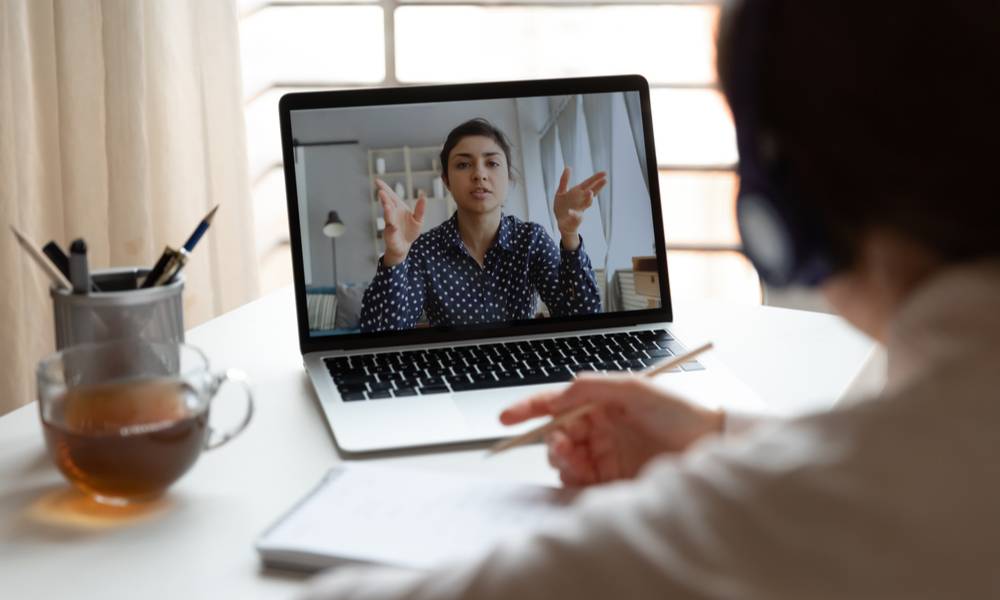Technology and mental health: The dos and don’ts of working from home during COVID-19
New research identifies proven strategies managers can put in place to support employees working remotely, as well as steps employees can adopt to utilise technology and work more effectively
As many employees continue to work from home during COVID-19, the boundaries between work and home have become increasingly blurred, and the link between technology and mental health becomes harder to ignore.
When technology is thoughtfully designed and used to consider the impact on how people do their work, then it can help alleviate some of the pressures of work. However, the constant use of technology can also lead to increased employee overload, exhaustion, stress and burnout.
As such, technological advances in the workplace can sometimes be a double-edged sword, says Leona Tan, Research Officer in the Workplace Mental Health Research Program at the Black Dog Institute. "Automation of processes like data entry can alleviate workloads, but increased screen time and sedentary behaviour due to prolonged technology use can lead to poorer physical and mental health outcomes, including increased symptoms of depression and anxiety," says Ms Tan.
This is the result of two significant technology-driven changes in the workplace: on how we work, and where and when we work, says Dr Markus Groth, Professor of Organisational Behaviour in the School of Management at UNSW Business School. But an understanding of these changes can help tackle some of the adverse effects of technological change and working in a post-COVID-19 world.
Interventions and access to online mental health training
Ms Tan and Prof. Groth are two co-authors of the peer-reviewed paper, A review and agenda for examining how technology-driven changes at work will impact workplace mental health and employee well-being, published in the Australian Journal of Management. The research explores existing studies of how accelerated technology-driven changes at work impact workplace mental health and employee wellbeing.
The authors explore the relationship between increased workloads and the impact on employees: stress, burnout and overload. The paper finds many positives to technology changes in the workplace. However, rapid changes can also lead to higher levels of work strain and distress through increased work pace, multitasking and interruptions.
"In terms of where we work, the COVID-19 pandemic has obviously also had a huge recent impact," says Prof. Groth, who says this also places more responsibility on individual employees to define the boundaries between work and non-work. "It's not going to be done for them anymore by managers or organisations."
The research identifies proven intervention strategies managers can put in place for employees working remotely, as well as the steps employees can take themselves to utilise technology and work more effectively. These steps can take place at three levels: at an individual level, team level or organisation level. Ideally, organisations want to use a mix of these approaches, says Prof. Groth.
"If there is a sense that someone needs support, setting up regular one-on-one informal catch-ups can help to let them know that support is available to them"
Leona Tan, Research Officer at the Black Dog Institute
At an individual level, managers can look to provide employees with resilience training, specific coaching, training in new technology, participative decision making, as well as specific training for managers and leaders, explains Prof. Groth.
At the team or organisational level, employees must be encouraged to feel like they're part of the change process, and this will also increase adaptation and acceptance of the change. Another example of a technological initiative that promotes mental health is online mental health training for managers. Managers or supervisors play a unique role with any given organisation where they are not only able to directly impact employee outcomes but are also able to influence the culture of the organisation, explains Ms Tan.
A recent study on online manager mental health training found that participants who received the training increased in their confidence in initiating mental health conversations as well improved responsive and preventive behaviours that can support the mental health needs of their direct employees. So managers who undergo online mental health training will also be better equipped and more confident to discuss mental health and wellbeing with employees, says Ms Tan.
Technology to promote interpersonal relationships
Maintaining quality interpersonal relationships during the COVID-19 pandemic is crucial to employee mental health. "Keeping in regular contact with employees and regular team catch-ups are a great way to maintain a sense of connection during this time, particularly when many employees are working remotely from different locations," says Ms Tan.
Managers and leaders should also keep an eye out for any changes in behaviour, not just in terms of productivity, but also in terms of demeanour and overall sense of engagement. "If there is a sense that someone needs support, setting up regular one-on-one informal catch-ups can help to let them know that support is available to them," explains Ms Tan.

But managers and leaders also need to check in with their own mental health needs, and this is where sharing experiences with the broader team can be very beneficial. "Acknowledging difficulties can help staff feel more comfortable about approaching managers and leaders for support if they are leading by example," continues Ms Tan.
It is also essential to schedule in time for social connections and interactions that would typically happen in-person, such as coffee catch-ups or team gatherings, online or in-person if possible. "Online peer support groups, mentoring, or even more social interactions such as games, trivia, quizzes can encourage interpersonal interactions and help create social connections, especially for those currently feeling isolated due to restrictions," she says.
Practical steps
The researchers suggest four practical steps business leaders can take to ensure technology supports employees:
1. Review current practices involving technology including flexible and remote working policies to assess the impact on mental health.
2. Establish and communicate expectations on availability during non-working hours and set reasonable boundaries around work-related technology use at home.
3. Seek advice from organisational and mental health professionals who can recommend evidence-based workplace mental health programs and practices, and encourage employee participation in the design and implementation of any future technologies.
4. Consider how technology can promote social connection and interaction, mainly when employees are working remotely and may feel isolated under current restrictions.

For those seeking to work better individually, the researchers suggest five proven strategies to ensure employees don't deplete personal resources and resilience:
1. Keep on top of how you are feeling from time-to-time and take note of any changes, including low or anxious feelings.
2. When working from home, set a routine and structure for your day to create boundaries between work and home. Try to stick to a regular start and finish time, and schedule sufficient breaks throughout the day. Go for a walk outside and give your mind and body time a chance to reset.
3. Create a working setup in your home, even if it is only a specific 'work' chair to establish a boundary between work and home. Avoid working in places of rest, such as the bedroom if possible. This will help you switch off from work and minimise work from intruding into the home and personal time.
4. Check-in with your colleagues and ask them to check in on you. These are unprecedented times, and it is essential to remember that you are not alone in how you feel and support is always available.
5. Get involved in organisational change. The current pandemic is also a potential opportunity for growth, and many businesses will have to adapt to evolving circumstances. Consider what changes you would like to see happen and how you might be able to get involved.
"We need a more interdisciplinary approach where we look at all the evidence: what are the psychological pros and cons and how can we make those work effectively"
Dr Markus Groth, Professor of Organisational Behaviour at UNSW Business School
Consider the future implications
The authors call for more high-quality research to be able to determine the best use of technology within the workplace and its impact on employee mental health in the future. "Well-designed longitudinal research studies can provide much-needed insight into the long-term impact of various types of technological use, and how best to minimise the risks on employee mental health," says Ms Tan.
"More close collaborations between researchers, mental health professionals, user experience specialists, industry and government bodies are required to gain a better understanding of the true impacts of technology through multiple perspectives, as well as how technology can be developed and used to mitigate any potential risks to mental health."
To design workplaces that promote significant working and support employee mental health and wellbeing, Prof Groth says an evidence-based approach is required to examine the impact of technology on work.
He says discussions around technological impacts on work have often focused solely on the technical side, in terms of what technology is available, how to implement it etc. "A lot of the time, organisations and other government bodies take a very compartmentalised approach. They look at some part of the evidence and not necessarily others," he says.
"We need a more interdisciplinary approach where we look at all the evidence: what are the psychological pros and cons and how can we make those work effectively."
Dr Markus Groth is a Professor of Organisational Behaviour in the School of Management at UNSW Business School. Leona Tan is a Research Officer in the Workplace Mental Health Research Program at the Black Dog Institute. For more information, please contact Professor Groth directly, read the paper here or visit the Australian Journal of Management.
